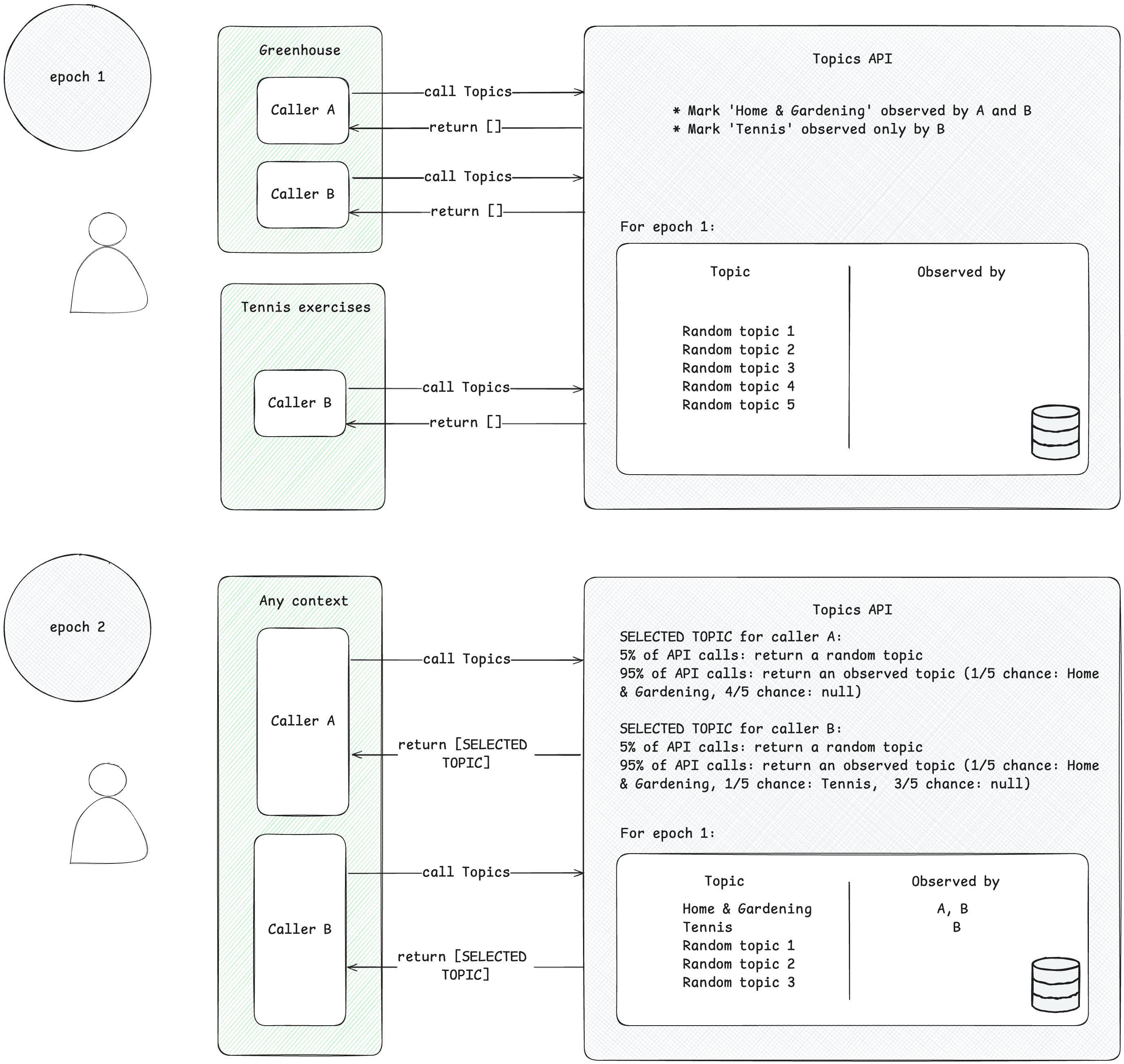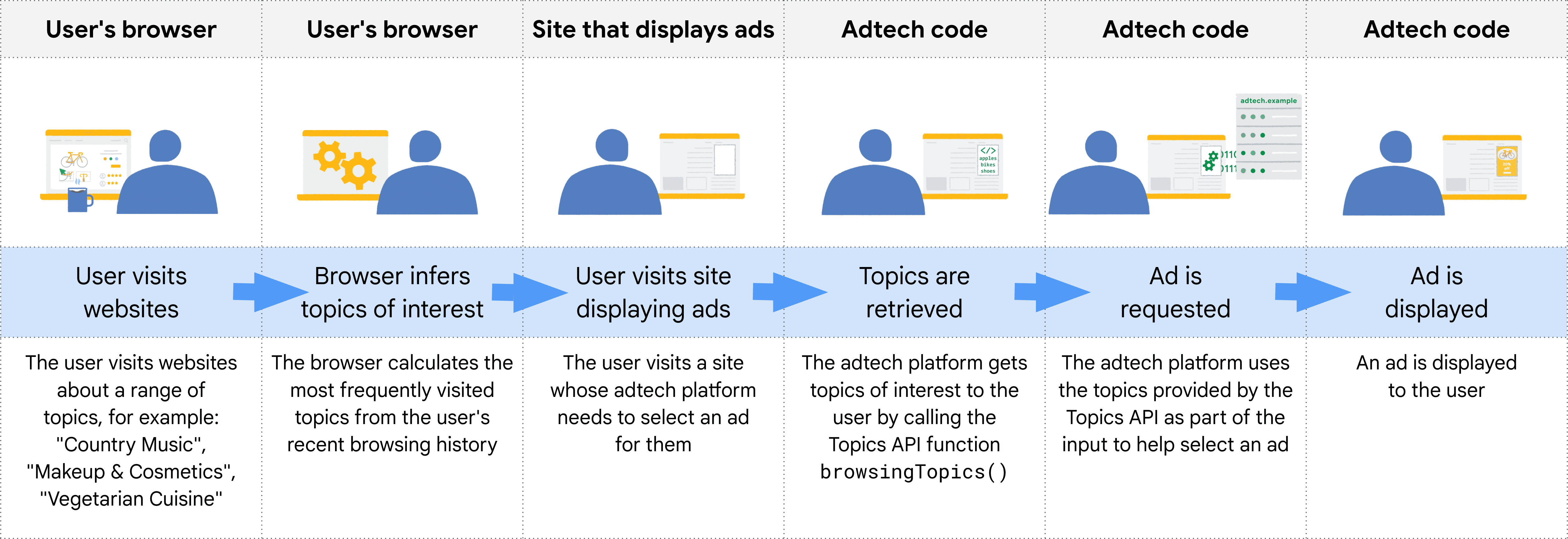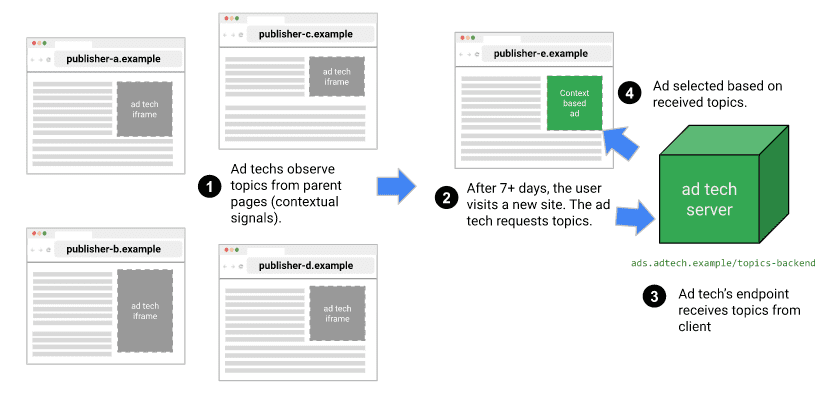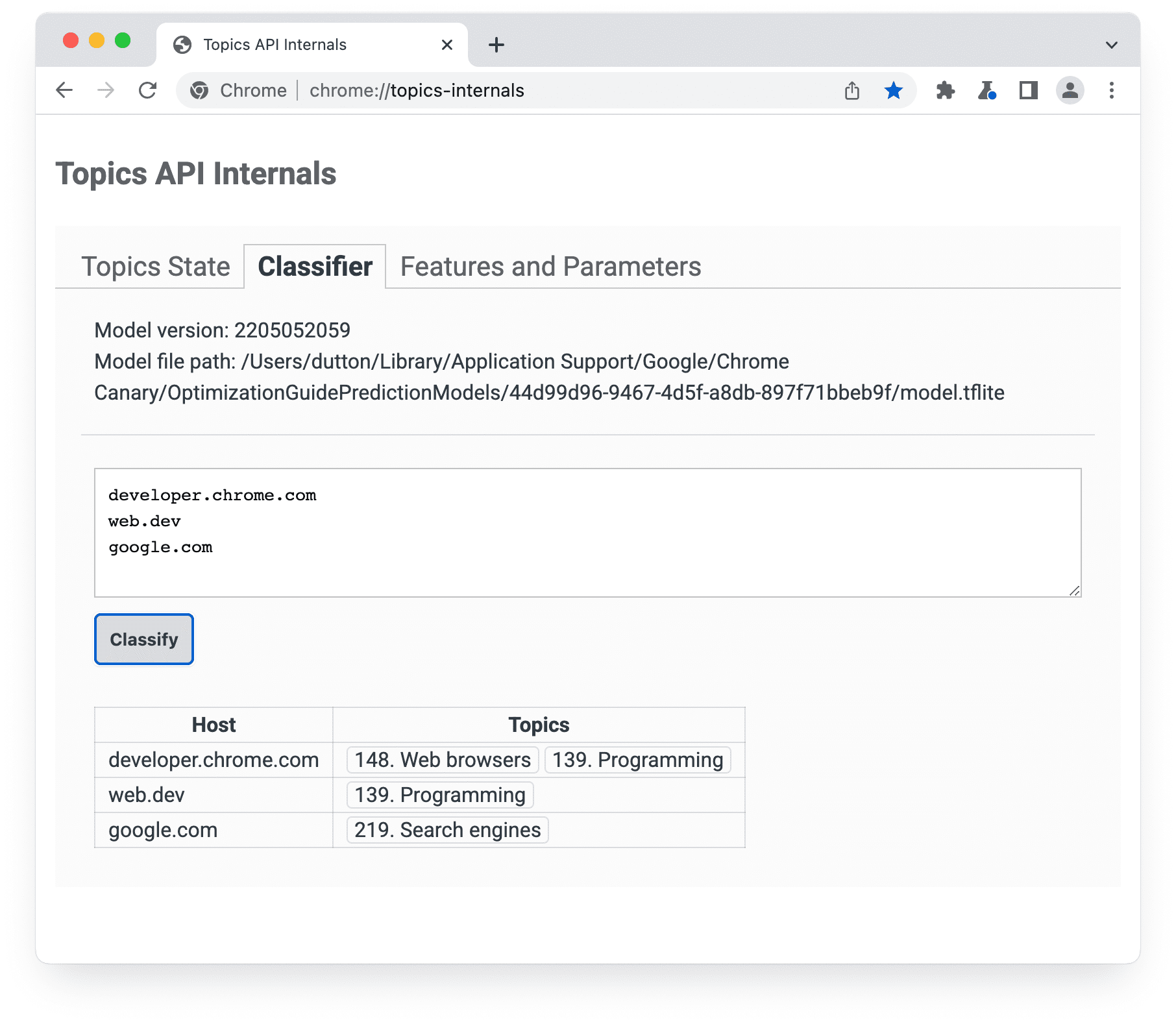Topics API, तीसरे पक्ष की कुकी का इस्तेमाल किए बिना, दिलचस्पी के हिसाब से विज्ञापन दिखाता है.
Topics API के काम करने का तरीका
Topics API का इस्तेमाल, उपयोगकर्ता की गतिविधि के आधार पर उन विषयों को देखने और उनका ऐक्सेस देने के लिए किया जा सकता है जिनमें उपयोगकर्ता की दिलचस्पी है. इसके बाद, Topics API, एपीआई कॉलर (जैसे, विज्ञापन टेक्नोलॉजी प्लैटफ़ॉर्म) को उपयोगकर्ता की दिलचस्पी के विषयों का ऐक्सेस दे सकता है. हालांकि, ऐसा करते समय उपयोगकर्ता की गतिविधि के बारे में अतिरिक्त जानकारी नहीं दी जाती.
मुख्य सिद्धांत
- विषय, मौजूदा उपयोगकर्ता की दिलचस्पी का ऐसा विषय होता है जिसे कोई भी व्यक्ति आसानी से पढ़ सकता है. यह विषयों की टैक्सोनॉमी का हिस्सा होता है.
- कॉल करने वाला कोई इकाई होती है. जैसे, कोई ऐप्लिकेशन, तीसरे पक्ष का एसडीके, वेबसाइट या सेवा. यह इकाई, उपयोगकर्ता की दिलचस्पी के विषयों को देखने या ऐक्सेस करने के लिए, Topics API से अनुरोध करती है.
- अगर कॉलर ने पिछले तीन समयावधि के दौरान, इस विषय से जुड़े किसी वेब पेज या ऐप्लिकेशन से Topics API का अनुरोध किया है, तो वह विषय कॉलर की निगरानी में होता है.
- एपॉच, विषय के हिसाब लगाने की अवधि होती है. यह डिफ़ॉल्ट रूप से एक हफ़्ते की होती है.
- टैक्सोनॉमी, कैटगरी की हैरारकी वाली सूची होती है. उदाहरण के लिए, इसमें
/Arts & Entertainment/Music & Audio/Soul & R&Bऔर/Business & Industrial/Business Services/Corporate Eventsजैसी कैटगरी शामिल होती हैं. - विषयों को डेटा की कैटगरी तय करने वाले मॉडल का इस्तेमाल करके बनाया जाता है. यह मॉडल, उपयोगकर्ता की गतिविधि को शून्य या उससे ज़्यादा विषयों से मैप करता है.
Topics API फ़्लो के मुख्य चरण
Topics API के लाइफ़साइकल में तीन मुख्य चरण होते हैं:
- उपयोगकर्ता की गतिविधि को निगरानी करें. जैसे, जब वे वेब पेज
https://cats.example/tabby/index.htmlपर जाते हैं या ऐप्लिकेशनcatsडाउनलोड करते हैं. - उपयोगकर्ता गतिविधि से विषय पाएं, जैसे कि
/Pets & Animals/Pets/Cats. - उपयोगकर्ता के लिए पहले से ऐसे विषयों को ऐक्सेस करना जिनमें उनकी दिलचस्पी है. उदाहरण के लिए, काम के विज्ञापन चुनने के लिए सिग्नल के तौर पर, बिल्ली के खाने का प्रमोशन.
विषयों को देखना
कॉल करने वाले लोग, सिर्फ़ उन विषयों को ऐक्सेस कर सकते हैं जिनमें उन्होंने दिलचस्पी दिखाई है. जब कोई कॉलर, इस विषय से जुड़े कॉन्टेक्स्ट से Topics API का अनुरोध करता है, तो वह उस विषय को निगरानी में रखता है. इस कॉन्सेप्ट को समझने के लिए, यहां दिया गया आसान उदाहरण देखें.
- मान लें कि Topics API के दो कॉलर हैं: A और B.
- दो तरह के संदर्भ होते हैं:
- Greenhouse, जैसे कि
Home & Gardenविषय से जुड़ा Greenhouse नाम का ऐप्लिकेशन या greenhouse.example वेबसाइट. - टेनिस की एक्सरसाइज़. उदाहरण के लिए,
Sports/Tennisविषय से जुड़ा Tennis Exercises नाम का ऐप्लिकेशन या tennis.example वेबसाइट.
- Greenhouse, जैसे कि
- कॉलर A और B, दोनों Greenhouse के संदर्भ में मौजूद हैं.
- टेनिस के व्यायाम के संदर्भ में, सिर्फ़ कॉल करने वाला B मौजूद है.
- आसानी से समझने के लिए, मान लें कि पहले एपच (अवधि) से पहले, उपयोगकर्ता के लिए कोई विषय नहीं देखा गया था.
- उपयोगकर्ता Greenhouse ऐप्लिकेशन पर जाता है और कॉलर A और B, उपयोगकर्ता के पेज या ऐप्लिकेशन पर आने की जानकारी रिकॉर्ड करने के लिए Topics API को कॉल करते हैं. Topics API को कॉल करने का तरीका जानने के लिए, अगले चरण में सुझाई गई, लागू करने की गाइड देखें. इस रिकॉर्ड (होस्टनेम या ऐप्लिकेशन डेटा) का इस्तेमाल, बाद में आपकी दिलचस्पी के विषयों का पता लगाने के लिए किया जाता है. Topics API, बाद में विषय
Home & Gardenको उस तरह से मार्क करेगा जिस तरह से कॉलर A और B ने देखा है. - उपयोगकर्ता, टेनिस की गतिविधियां ऐप्लिकेशन पर जाता है. सिर्फ़ कॉलर B, Topics API का अनुरोध भेजता है. Topics API बाद में, विषय
Sports/Tennisको कॉलर B के हिसाब से मार्क करेगा. - एपॉच के खत्म होने तक, Topics API उपयोगकर्ता के सबसे ज़्यादा देखे गए विषयों को रीफ़्रेश कर देता है. साथ ही, उपयोगकर्ता की गतिविधि के आधार पर उन कॉलर का पता लगाता है जिन्होंने इन विषयों को देखा है.
- बाद में, जब कॉल करने वाला B, Topics API को कोई दूसरा कॉल करता है, तो उसे रिस्पॉन्स कलेक्शन में इस उपयोगकर्ता के लिए
Home & GardenयाSports/Tennisविषय मिल सकता है. इसके अलावा, 5% संभावना के साथ कोई दूसरा विषय भी मिल सकता है. - कॉलर A सिर्फ़ विषय
Home & Gardenको ऐक्सेस कर सकता है, क्योंकि उसने विषयSports/Tennisको कभी नहीं देखा है. इसका मतलब है कि तीसरे पक्ष को उपयोगकर्ता के पसंदीदा विषय के बारे में सिर्फ़ उस खास संदर्भ (ऐप्लिकेशन या वेबसाइट) में पता चलेगा जहां वह मौजूद है.

विषयों को चुनना
Topics, उपयोगकर्ता की गतिविधि से दिलचस्पी के विषयों का पता लगाता है. ये विषय, पहले से तय किए गए ओपन-सोर्स टैक्सोनॉमी से चुने जाते हैं. हर एपॉच में एक बार, Topics उपयोगकर्ता के सबसे ज़्यादा ब्राउज़ किए गए पांच विषयों और उन कॉलर को रीफ़्रेश करता है जिन्होंने एपॉच के दौरान उन्हें देखा था. Topics का डेटा की कैटगरी तय करने वाला मॉडल, उपयोगकर्ता की गतिविधि से विषयों का पता लगाता है: वेब पेज पर विज़िट के लिए होस्टनेम, Android पर ऐप्लिकेशन की जानकारी.
कॉल करने वाला व्यक्ति, उपयोगकर्ता की दिलचस्पी के विषयों को ऐक्सेस करता है
एपीआई सिर्फ़ वे विषय दिखाता है जिन्हें कॉल करने वाले ने हाल ही के तीन समयावधि में देखा है. कॉलर को ज़्यादा से ज़्यादा तीन विषय दिखाए जा सकते हैं. इनमें से हर विषय, हाल ही के तीन एपिसोड में से किसी एक का होगा. हालांकि, ऐसा तब ही होगा, जब कॉलर ने उस एपिसोड के लिए विषयों को देखा हो. कॉल करने वाला व्यक्ति, दिए गए विषयों का इस्तेमाल संदर्भ से जुड़ी जानकारी को बेहतर बनाने के लिए कर सकता है. साथ ही, इन विषयों को जोड़कर उपयोगकर्ता के लिए ज़्यादा काम का विज्ञापन ढूंढा जा सकता है.
इकोसिस्टम
Topics API को यह पक्का करना होगा कि दिलचस्पी के विषयों की जानकारी अप-टू-डेट हो. किसी उपयोगकर्ता के लिए विषयों का अनुमान, उसकी गतिविधि के आधार पर लगाया जाता है. यह गतिविधि, किसी तय समयावधि के दौरान की जाती है. इस समयावधि को 'एपॉच' कहते हैं. डिफ़ॉल्ट रूप से, यह समयावधि एक हफ़्ते की होती है. हर उपयोगकर्ता के लिए, एपिसोड का शुरू होने का समय अलग-अलग होता है. साथ ही, यह समय भी रैंडम होता है.
हर युग के बाद, Topics API उपयोगकर्ता के सबसे ज़्यादा ब्राउज़ किए गए पांच विषयों का हिसाब लगाता है. साथ ही, यह भी तय करता है कि किन कॉलर ने डिवाइस पर मौजूद जानकारी का इस्तेमाल करके उन विषयों को देखा. हर epoch का विषय, उस समयावधि में उपयोगकर्ता के सबसे ज़्यादा ब्राउज़ किए गए पांच विषयों में से चुना जाता है. यह किसी भी क्रम में हो सकता है. निजता को और बेहतर बनाने और यह पक्का करने के लिए कि सभी विषयों को दिखाया जा सके, दिलचस्पी के टैक्सोनॉमी में मौजूद सभी संभावित विषयों में से किसी एक विषय को रैंडम तौर पर चुने जाने की 5% संभावना होती है.
वेब पर विषयों को इस्तेमाल करने का तरीका
वेब पर, विषयों का अनुमान, उपयोगकर्ता के देखे गए पेजों के होस्टनेम से लगाया जाता है. उदाहरण के लिए, वेबसाइट dogs.example के लिए अनुमानित विषय /पालतू जानवर और जानवर/पालतू जानवर/कुत्ते हो सकता है.
यहां दिए गए डायग्राम में एक आसान उदाहरण दिया गया है. इससे पता चलता है कि Topics API, विज्ञापन टेक्नोलॉजी प्लैटफ़ॉर्म को सही विज्ञापन चुनने में कैसे मदद कर सकता है. इस उदाहरण में यह माना गया है कि उपयोगकर्ता के ब्राउज़र में पहले से ही एक मॉडल मौजूद है, जो वेबसाइट के होस्टनेम को विषयों से मैप करता है.

ब्राउज़र, Topics API को कॉल करने वाले कोड के कॉन्टेक्स्ट से कॉलर के ऑरिजिन का पता लगाता है. इसका मतलब है कि Topics के उपयोगकर्ता, अपने ऑरिजिन से iframe में एपीआई को कॉल करते हैं या अपने ऑरिजिन में फ़ेच में विषयों को शामिल करते हैं.
उदाहरण के लिए, सप्लाई-साइड प्लैटफ़ॉर्म (एसएसपी) को कई पब्लिशर की साइटों पर एम्बेड किया जा सकता है. इसके बाद, एसएसपी अपने शुरुआत की जगह से iframe में Topics API को कॉल कर सकता है. इससे, वह पब्लिशर की साइटों पर उपयोगकर्ता से जुड़े विषयों को देख सकता है. इसके बाद, इन विषयों को मांग पक्ष के प्लैटफ़ॉर्म (डीएसपी) के साथ शेयर किया जा सकता है, ताकि वह उपयोगकर्ता के लिए काम का विज्ञापन चुन सके.
एपीआई यह कैसे तय करता है कि कॉल करने वाले लोगों को कौनसे विषय दिखें
API कॉलर को सिर्फ़ वे विषय मिलते हैं जिन्हें उन्होंने हाल ही में देखा है. साथ ही, किसी उपयोगकर्ता के लिए विषयों को हर एपच में एक बार रीफ़्रेश किया जाता है. एपच, एक समयावधि होती है. Chrome में इसे एक हफ़्ते के लिए सेट किया गया है. इसका मतलब है कि एपीआई एक रोलिंग विंडो उपलब्ध कराता है, जिसमें कॉल करने वाले व्यक्ति को निगरानी में रखे गए विषय मिल सकते हैं.
नीचे दी गई टेबल में, किसी एक एपिक के दौरान उपयोगकर्ता के ब्राउज़िंग इतिहास का एक उदाहरण दिया गया है. हालांकि, यह उदाहरण काल्पनिक है और इसमें बहुत कम जानकारी दी गई है. इसमें, उपयोगकर्ता की विज़िट की गई साइटों से जुड़े विषयों के साथ-साथ, हर साइट पर मौजूद एपीआई कॉलर (वे इकाइयां जो साइट पर मौजूद JavaScript कोड में document.browsingTopics() को कॉल करती हैं) की जानकारी दी गई है.
| साइट | विषय | साइट पर एपीआई कॉल करने वाले |
|---|---|---|
| running.example | Running & WalkingAthletic Shoes |
adtech1.example adtech2.example |
| dogs.example | Dogs |
adtech1.example |
| holiday.example | Hotels & Accommodations |
adtech2.example |
| sunglasses.example | Sunglasses |
[none] |
किसी खास समयावधि (डिफ़ॉल्ट रूप से एक हफ़्ता) के आखिर में, Topics API उस हफ़्ते के लिए ब्राउज़र के सबसे ज़्यादा लोकप्रिय विषयों की जानकारी जनरेट करता है.
- adtech1.example को अब
Running & Walking,Athletic Shoes, औरDogsविषय मिल सकते हैं, क्योंकि उसने running.example और dogs.example पर इन विषयों को देखा है. - adtech1.example, इस उपयोगकर्ता के लिए
Hotels & Accommodationsविषय नहीं दिखा सकता, क्योंकि वह उस विषय से जुड़ी उन साइटों पर मौजूद नहीं है जिन पर उपयोगकर्ता ने हाल ही में विज़िट किया है. - adtech2.example को
Running & Walking,Athletic Shoes, औरHotels & Accommodationsविषय दिखे हैं, लेकिनDogsविषय नहीं दिखे हैं.
उपयोगकर्ता ने sunglasses.example पर विज़िट किया, जिस पर Sunglasses विषय है. हालांकि, उस साइट पर Topics API को कोई कॉल नहीं किया गया. इसका मतलब है कि एपीआई किसी भी कॉलर के लिए Sunglasses विषय नहीं दिखाएगा.
दूसरे हफ़्ते में, उपयोगकर्ता किसी दूसरी साइट पर जाता है:
| साइट | विषय | साइट पर एपीआई कॉल करने वाले |
|---|---|---|
| cameras.example | Camera & Photo Equipment |
adtech2.example |
इसके अलावा, adtech2.example का कोड sunglasses.example में जोड़ा जाता है:
| साइट | विषय | साइट पर एपीआई कॉल करने वाले |
|---|---|---|
| sunglasses.example | Sunglasses |
adtech2.example |
इसका मतलब है कि adtech2.example को अब पहले हफ़्ते के Running & Walking, Athletic Shoes, और Hotels & Accommodations के साथ-साथ Camera & Photo Equipment और Sunglasses विषय भी मिलेंगे. हालांकि, ये विषय उसे तीसरे हफ़्ते तक नहीं मिलेंगे. इससे यह पक्का होता है कि तीसरे पक्ष, कुकी की तुलना में उपयोगकर्ता के अतीत (इस मामले में, फ़ैशन में दिलचस्पी) के बारे में ज़्यादा नहीं जान सकते.
अगर उपयोगकर्ता उन विषयों से जुड़ी किसी भी साइट पर नहीं जाता है जिनमें adtech2.example का कोड शामिल है, तो दो हफ़्ते बाद Running & Walking, Athletic Shoes, और Hotels & Accommodations, ज़रूरी शर्तें पूरी करने वाले विषयों की adtech2.example की सूची से हट सकते हैं.

डेटा की कैटगरी तय करने वाला मॉडल
Topics, क्लासिफ़ायर मॉडल का इस्तेमाल करता है. यह मॉडल, वेबसाइट के होस्टनेम को शून्य या एक से ज़्यादा विषयों से मैप करता है. पूरे यूआरएल या पेज के कॉन्टेंट जैसी अन्य जानकारी का विश्लेषण करने से, ज़्यादा काम के विज्ञापन दिखाए जा सकते हैं. हालांकि, इससे निजता भी कम हो सकती है.
टैक्सनॉमी
विषयों को टैक्सोनॉमी से चुना जाता है. इन विषयों को Chrome ने चुना है. इसका मकसद यह है कि टैक्सोनॉमी, भरोसेमंद नेटवर्क के योगदान देने वालों के बनाए संसाधन बन जाए. टैक्सोनॉमी का साइज़ इतना छोटा होना चाहिए कि कई उपयोगकर्ताओं के ब्राउज़र हर विषय से जुड़े हों. हमारा मकसद है कि टैक्सोनॉमी, किसी बाहरी पार्टी से उपलब्ध कराई जाए. इस पार्टी में, पूरे इंडस्ट्री के सुझाव और राय शामिल होनी चाहिए.
संवेदनशील कैटगरी से बचने के लिए, विषयों को सार्वजनिक होना चाहिए. साथ ही, उन्हें मैन्युअल तरीके से चुना जाना चाहिए और अप-टू-डेट रखना चाहिए. Chrome में इस्तेमाल की जाने वाली टैक्सोनॉमी को मनुष्य ने बनाया है, ताकि आम तौर पर संवेदनशील मानी जाने वाली कैटगरी को शामिल न किया जा सके. जैसे, नस्ल या यौन रुझान.
विषयों की कैटगरी
सबसे लोकप्रिय 50,000 साइटों के लिए, विषयों को मैन्युअल तरीके से चुना जाता है. साथ ही, होस्टनेम और विषयों की इस चुनी गई सूची का इस्तेमाल, क्लासिफ़ायर मॉडल को ट्रेन करने के लिए किया जाता है. टॉप साइटों के लिए, विषयों को क्लासिफ़ायर मॉडल का इस्तेमाल करने के बजाय, बदलाव करने की सूची से ऐक्सेस किया जाता है. ओवरराइड की सूची को अपने कंप्यूटर पर देखा जा सकता है.

chrome://topics-internals पेज के 'डेटा की कैटगरी तय करने वाला' पैनल में, मॉडल का वर्शन, उसका पाथ, और सूची में शामिल हर होस्ट से जुड़े विषयों की जानकारी होती है.Chrome में Topics API लागू करने पर, मॉडल की जानकारी देने वाली TensorFlow Lite फ़ाइल डाउनलोड की जाती है, ताकि उसका इस्तेमाल उपयोगकर्ता के डिवाइस पर किया जा सके.
उपयोगकर्ता के सबसे ज़्यादा ब्राउज़ किए गए पांच विषयों को चुनने का तरीका
एपीआई, हर एपच के लिए एक विषय दिखाता है. हालांकि, ज़्यादा से ज़्यादा तीन विषय दिखाए जा सकते हैं. अगर तीन वैल्यू दिखती हैं, तो इसमें मौजूदा और पिछले दो एपर्च्यूज़ के विषय शामिल होते हैं.
- हर युग के आखिर में, ब्राउज़र उन पेजों की सूची बनाता है जो इन शर्तों को पूरा करते हैं:
- उपयोगकर्ता ने उस पेज पर, 'एपॉच' के दौरान विज़िट किया था.
- पेज में ऐसा कोड शामिल है जो
document.browsingTopics()को कॉल करता है. - एपीआई चालू था (उदाहरण के लिए, उपयोगकर्ता या रिस्पॉन्स हेडर ने उसे ब्लॉक नहीं किया था).
- उपयोगकर्ता के डिवाइस पर ब्राउज़र, Topics API से मिले क्लासिफ़ायर मॉडल का इस्तेमाल करता है. इससे, हर पेज के होस्टनेम को विषयों की सूची से मैप किया जाता है.
ब्राउज़र, सबसे ज़्यादा खोजे गए पांच विषयों की सूची जनरेट करता है.
- विज्ञापन नेटवर्क से मिले सुझावों के आधार पर, टैक्सोनॉमी के हर रूट विषय को "ज़्यादा उपयोगिता" या "स्टैंडर्ड उपयोगिता" बकेट में से किसी एक में असाइन किया जाता है. ब्राउज़र, विषयों को पहले उनके बकेट असाइनमेंट के हिसाब से क्रम में लगाता है. सभी डेसेंटेंट टॉपिक, अपने पैरंट रूट टॉपिक का बकेट असाइनमेंट इनहेरिट करते हैं. "ज़्यादा काम के" विषयों को प्राथमिकता दी जाती है.
- इसके बाद, ब्राउज़र हर बकेट में विषयों को फ़्रीक्वेंसी के हिसाब से क्रम में लगाता है.
- क्रम से लगाई गई इस सूची में से, उपयोगकर्ता के उस समयावधि के लिए सबसे ज़्यादा ब्राउज़ किए गए पांच विषय चुने जाते हैं.
इसके बाद, document.browsingTopics() तरीका हर युग के लिए, सबसे ज़्यादा ब्राउज़ किए गए पांच विषयों में से कोई एक विषय चुनता है. साथ ही, इस बात की 5% संभावना होती है कि इनमें से कोई भी विषय, विषयों के पूरे टैक्सोनॉमी से किसी भी क्रम में चुना जा सकता है. Chrome में, उपयोगकर्ता अलग-अलग विषयों को हटा सकते हैं या अपना ब्राउज़िंग इतिहास मिटा सकते हैं. इससे, एपीआई से मिलने वाले विषयों की संख्या कम हो जाती है. उपयोगकर्ता, एपीआई से ऑप्ट आउट भी कर सकते हैं.
chrome://topics-internals पेज पर जाकर, मौजूदा समयावधि के दौरान देखे गए विषयों के बारे में जानकारी देखी जा सकती है.
आगे क्या करना होगा
सेटअप करना
विषय लागू करना
इन्हें भी देखें
वेब पर Topics API को बेहतर तरीके से समझने के लिए, हमारे संसाधन देखें.
- Topics में डेमो, कोलैब, और सिलसिलेवार तरीके से निर्देश देने वाले वीडियो देखें.
- Chrome फ़्लैग की सूची देखें. इससे डेवलपर, टेस्टिंग के लिए Topics API को पसंद के मुताबिक बना सकते हैं.
- देखें कि उपयोगकर्ता और डेवलपर, एपीआई को कैसे कंट्रोल कर सकते हैं.
- तकनीकी जानकारी और सहायता के लिए संसाधन देखें. सवाल पूछें, उनसे जुड़ें और सुझाव शेयर करें.



